Understanding consumer decision making has become much more complex given the rise of digital and social media. Online has grown as a sales channel, accounting for c. 9% of US retail sales in 2015. But a further 46% of sales are bought offline but influenced by online, according to eMarketer here. Below I look at how to better understand ‘consumer decision journeys’, drawing on an executive program I recently delivered on this topic at London Business School (LBS).
1. Forget the fairytale of the funnel
When preparing for the LBS program, I reviewed the literature on consumer decision making. And it was shocking to see how much of this still portrayed this process as a linear ‘funnel’, neatly narrowing from ‘problem recognition’ through to consideration and purchase. This is of course a fairytale view of how people buy, as you will know simply from your own personal experience. In reality, decision making is messier and much less rational.
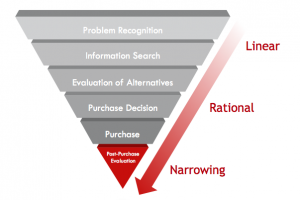
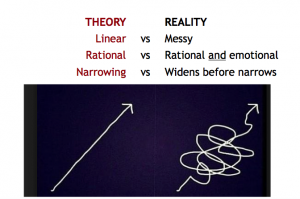
2. Map the consumer decision journey
A consumer decision framework is shown below, which is our take on a model proposed by McKinsey (based on a study of purchase decisions of nearly 20,000 consumers across five industries). There are a few important differences vs. the theoretical funnel shown earlier:
- Initial awareness: people already have brands in their head before a ‘trigger’ causes them to start searching more widely
- Widens first: the number of brands under consideration widens before it narrows
- Feedback loop: users share their experience of the brand with others
- Purchase loop: users decide to re-purchase, re-consider or reject the brand
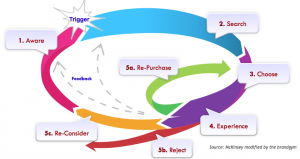
3. Boosting brand awareness matters
A key step is understanding the consumer decision journey for your particular category. The chart below shows what % of brands were added to the consideration set by stage. Notice also how important the ‘Aware’ stage is. Leaving aside auto insurance, between 38% and 63% of brand consideration come from this stage. Yes, brands get added in at the Search stage. But boosting brand awareness by creating ‘memory structure’ with distinctive marketing is vitally important. “Faced with a plethora of choices and communications, consumers fall back on the limited set of brands that have made it through the wilderness of messages. Brand awareness matters,” say McKinsey here. The lower Aware figure for auto insurance reflects the fact that 78% of people bought the same brand without considering others, showing how hard it is to break consumers out of their ‘inertia’ in this relatively low interest category.
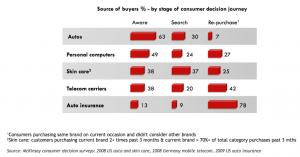
4. Adjust your marketing mix by stage of journey
Most of the noise today is about digital and social media, and these channels are of course increasingly important, as I flagged at the start of this post. However, the role of these media versus traditional media varies depending on the stage of the decision journey. ‘Customer-driven’ marketing like online research and word-of-mouth is important at the Search stage, as you’d expect, and also at the Choose stage. But ‘company-driven’ marketing like advertising and sponsorship still plays a leading role in the Aware stage, along with past experience of products/services. Building memory structure through distinctive marketing remains a crucial task for your brand, to get it into the consideration set before people even know they need you.
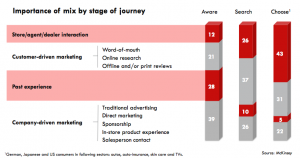
In conclusion, in today’s more complex world, its worth taking time to reflect on the consumer decision journey in your category. This means forgetting the fairytale funnel model of decision making to map why people really buy, understanding the importance of each stage of the journey and the most effective marketing mix levers to use as people move through these stages.
